10+ Diversity Training Program Examples to Download
Having an inclusive pool of employees (i.e., teachers, educators, healthcare workers, etc.) requires diversity training programs to reduce the risks of workplace discrimination and harassment claims, and avoid stereotypes — common factors that hinder career growth (promotion). Also, one or a combination of these issues are commonly indicated in an HR complaint letter submitted, which is very alarming on your end as the employer and the diversity manager. Creating a diversity training program is complicated, let alone deciding where to start. So, if you need some ideas, we have over 8 examples to guide you.
10+ Diversity Training Program Examples
1. Diversity Training Program Template
2. Faculty Diversity Training Program
3. Cultural Diversity Training Program
4. Basic Diversity Training Program
5. Diversity Training Program in PDF
6. Diversity Training Branch Program
7. Diversity Training Program Example
8. Printable Diversity Training Program
9. Supplier Diversity Training Program
10. Standard Diversity Training Program
11. Diversity Training Program in DOC
Diversity Training Program: What Is It and Its Goal
With organizations having a diverse workforce, diversity and inclusion become more of a business imperative. As part of a holistic approach to building an all-inclusive workplace, diversity training is conducted to educate members of the organization and promote inclusive thinking among them; from customers and co-workers to partners and vendors, among others. To ensure its success, having an effective diversity training program is a must. How’s it done? Let’s learn further below!
Helpful Tips for Making a Diversity Training Program
Having a diversity training program can improve equality in your workplace. Wonder how? Here’s how it’s done:
Tip 1: Tailor the Program to Your Company and Needs
Every company faces inclusivity issues differently. For one, a company may be facing racism as a critical workplace incident more than the other. Some companies may also have employees having different values from one another, hindering a harmonious relationship among them. As such, you need a comprehensive, in-depth understanding of your company and needs; and extensive organizational knowledge. This is when a training needs assessment should be conducted to get you started on the right map in creating your diversity and inclusion course.
Tip 2: Create Common Goals
After getting to know your company more deeply and identifying the organizational needs, create common goals. Always remember that common goals create common bonds. This works the same way in an inclusive leadership training program. Think our revolutionary heroes. Without their courage and pioneerism, our society, our world, will be a better one today.
Tip 3: Address Unconscious Biases
Scientifically, everyone has unconscious biases that originate in amygdala — the part of the brain that reacts strongly upon seeing pictures of races or figures different from its owner. This is why it’s very inevitable that body-shaming, racism, or other forms of discrimination are also present in the workplace. So, in your diversity training program, don’t forget to cover this hindering factor towards an inclusive workplace.
By recognizing and addressing the “territorial” or tribal nature of people, we can remove this “other-ness” response.
Tip 4: Keep Off from Prohibitive Language
Adults don’t like to be told what to do and what not to do. That is why you need to introduce the idea of choosing to lean into a diverse workplace and its benefits to the employees rather than demanding that they should all accept each other and their differences. You should also understand, that to some, accepting other’s differences may be difficult, and there can be one or more factors behind that.
FAQs
What Is the Importance of Diversity Training?
Diversity training helps employees understand each other’s different perspectives and encourage awareness of how they treat each other — increased workplace diversity and sensitivity.
Are Diversity Training Programs Legal?
Attending diversity training programs does not require an agreement. However, employers can require attendance at work-related training on diversity, harassment prevention, and discrimination. The program often includes a combination of legal matters and less concrete concepts.
What Are the Benefits of Diversity?
Leaning into diversity encourages employees, at an individual level, to be open to a variety of perspectives, increase creativity and productivity, and reduce fear of harassment. This can also make a huge impact globally not just in the corporate arena.
Diversity and inclusion training programs help create more welcoming workplaces where members respect each other’s differences and give voice to those who are often underrepresented. With a comprehensive program plan, the likelihood of achieving an inclusive workplace can be increased. As a diversity manager, we understand that you have a lot to look into in creating your diversity training program. This is why we are here to help you get started with our list of examples and templates above. So, if you need some ideas, make good use of them.
For more references in creating your training program, please check our employee training program examples and program schedule examples.
10+ Diversity Training Program Examples to Download

Having an inclusive pool of employees (i.e., teachers, educators, healthcare workers, etc.) requires diversity training programs to reduce the risks of workplace discrimination and harassment claims, and avoid stereotypes — common factors that hinder career growth (promotion). Also, one or a combination of these issues are commonly indicated in an HR complaint letter submitted, which is very alarming on your end as the employer and the diversity manager. Creating a diversity training program is complicated, let alone deciding where to start. So, if you need some ideas, we have over 8 examples to guide you.
10+ Diversity Training Program Examples
1. Diversity Training Program Template

iafc.org
Details
File Format
PDF
Size: 871 KB
2. Faculty Diversity Training Program
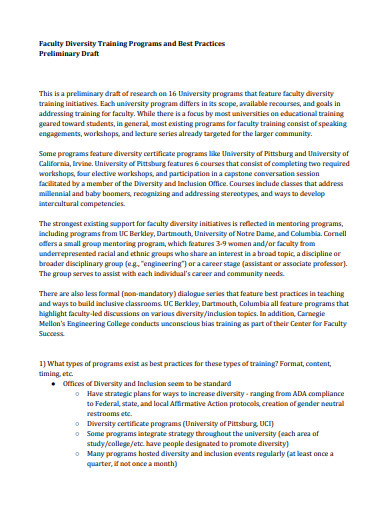
academicsenate.usc.edu
Details
File Format
PDF
Size: 183 KB
3. Cultural Diversity Training Program
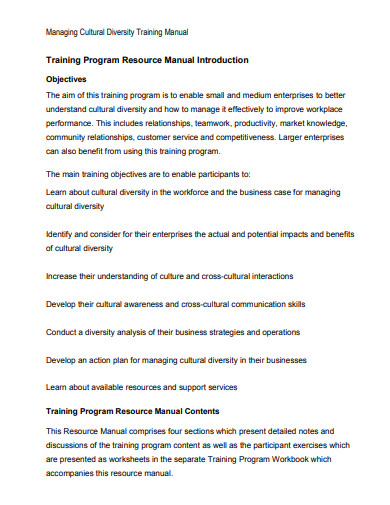
amf.net.au
Details
File Format
PDF
Size: 1 MB
4. Basic Diversity Training Program
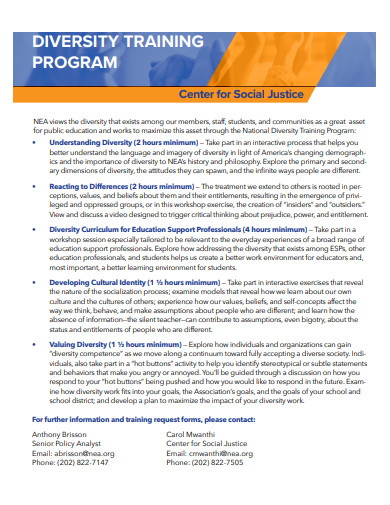
nea.org
Details
File Format
PDF
Size: 305 KB
5. Diversity Training Program in PDF
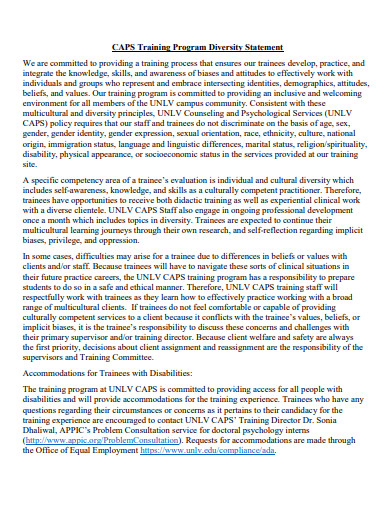
unlv.edu
Details
File Format
PDF
Size: 247 KB
6. Diversity Training Branch Program

cancer.gov
Details
File Format
PDF
Size: 148 KB
7. Diversity Training Program Example
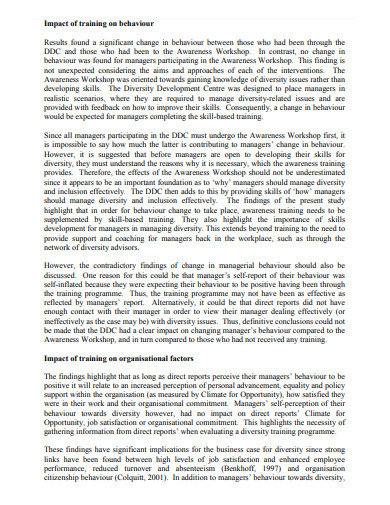
ufhrd.co.uk
Details
File Format
PDF
Size: 164 KB
8. Printable Diversity Training Program
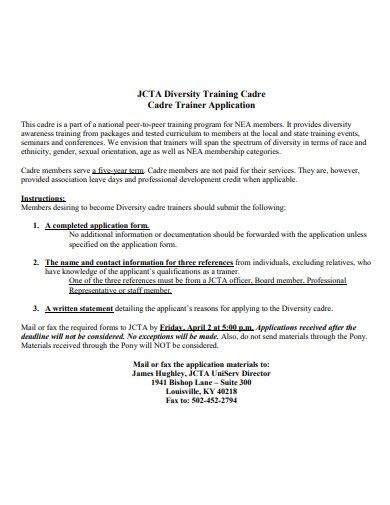
jcta.org
Details
File Format
PDF
Size: 101 KB
9. Supplier Diversity Training Program
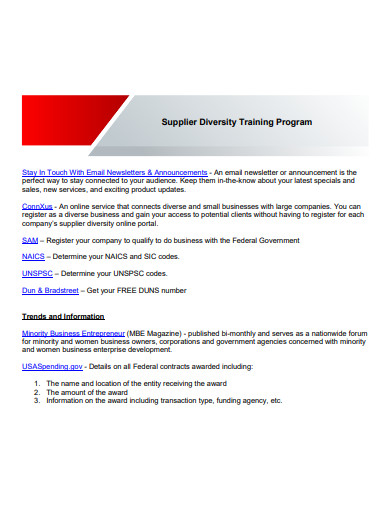
oracle.com
Details
File Format
PDF
Size: 117 KB
10. Standard Diversity Training Program
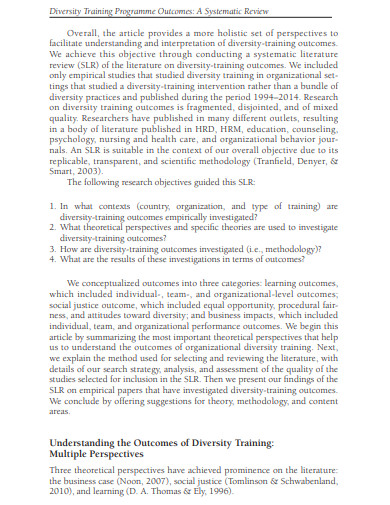
iitd.ie
Details
File Format
PDF
Size: 813 KB
11. Diversity Training Program in DOC
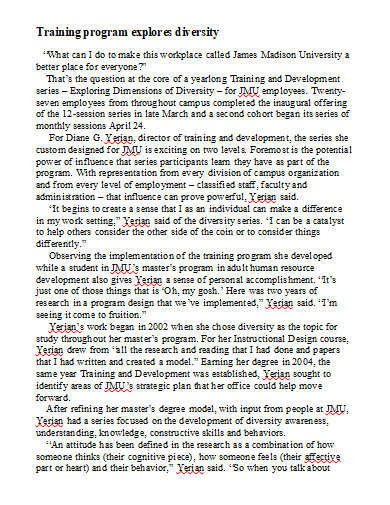
jmu.edu
Details
File Format
DOC
Size: 5 KB
Diversity Training Program: What Is It and Its Goal
With organizations having a diverse workforce, diversity and inclusion become more of a business imperative. As part of a holistic approach to building an all-inclusive workplace, diversity training is conducted to educate members of the organization and promote inclusive thinking among them; from customers and co-workers to partners and vendors, among others. To ensure its success, having an effective diversity training program is a must. How’s it done? Let’s learn further below!
Helpful Tips for Making a Diversity Training Program
Having a diversity training program can improve equality in your workplace. Wonder how? Here’s how it’s done:
Tip 1: Tailor the Program to Your Company and Needs
Every company faces inclusivity issues differently. For one, a company may be facing racism as a critical workplace incident more than the other. Some companies may also have employees having different values from one another, hindering a harmonious relationship among them. As such, you need a comprehensive, in-depth understanding of your company and needs; and extensive organizational knowledge. This is when a training needs assessment should be conducted to get you started on the right map in creating your diversity and inclusion course.
Tip 2: Create Common Goals
After getting to know your company more deeply and identifying the organizational needs, create common goals. Always remember that common goals create common bonds. This works the same way in an inclusive leadership training program. Think our revolutionary heroes. Without their courage and pioneerism, our society, our world, will be a better one today.
Tip 3: Address Unconscious Biases
Scientifically, everyone has unconscious biases that originate in amygdala — the part of the brain that reacts strongly upon seeing pictures of races or figures different from its owner. This is why it’s very inevitable that body-shaming, racism, or other forms of discrimination are also present in the workplace. So, in your diversity training program, don’t forget to cover this hindering factor towards an inclusive workplace.
By recognizing and addressing the “territorial” or tribal nature of people, we can remove this “other-ness” response.
Tip 4: Keep Off from Prohibitive Language
Adults don’t like to be told what to do and what not to do. That is why you need to introduce the idea of choosing to lean into a diverse workplace and its benefits to the employees rather than demanding that they should all accept each other and their differences. You should also understand, that to some, accepting other’s differences may be difficult, and there can be one or more factors behind that.
FAQs
What Is the Importance of Diversity Training?
Diversity training helps employees understand each other’s different perspectives and encourage awareness of how they treat each other — increased workplace diversity and sensitivity.
Are Diversity Training Programs Legal?
Attending diversity training programs does not require an agreement. However, employers can require attendance at work-related training on diversity, harassment prevention, and discrimination. The program often includes a combination of legal matters and less concrete concepts.
What Are the Benefits of Diversity?
Leaning into diversity encourages employees, at an individual level, to be open to a variety of perspectives, increase creativity and productivity, and reduce fear of harassment. This can also make a huge impact globally not just in the corporate arena.
Diversity and inclusion training programs help create more welcoming workplaces where members respect each other’s differences and give voice to those who are often underrepresented. With a comprehensive program plan, the likelihood of achieving an inclusive workplace can be increased. As a diversity manager, we understand that you have a lot to look into in creating your diversity training program. This is why we are here to help you get started with our list of examples and templates above. So, if you need some ideas, make good use of them.
For more references in creating your training program, please check our employee training program examples and program schedule examples.

